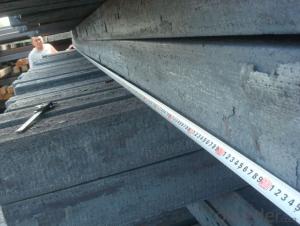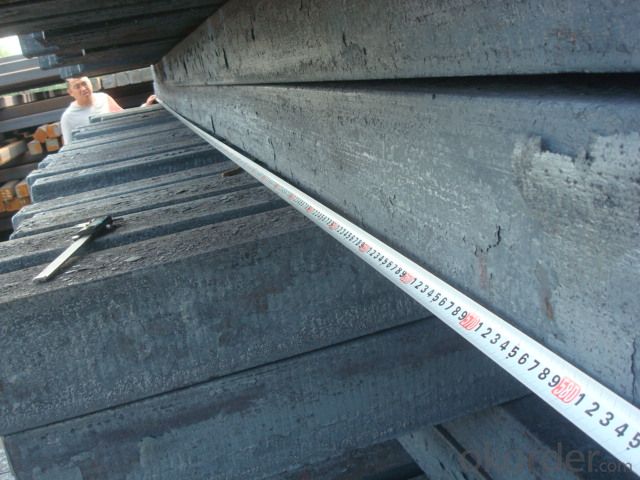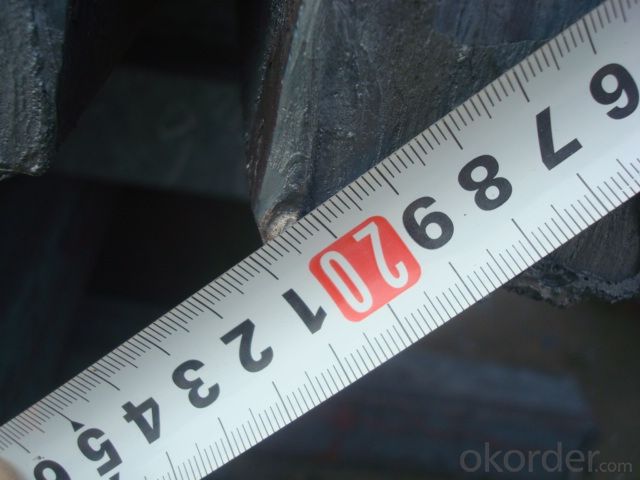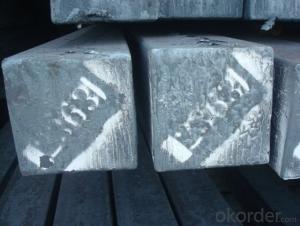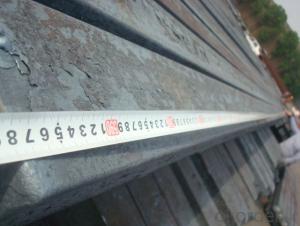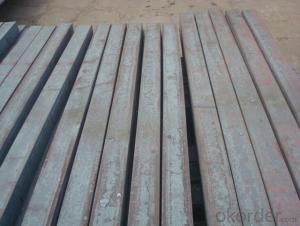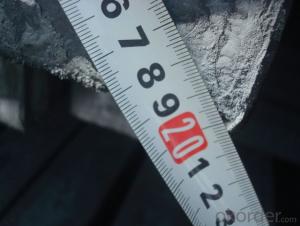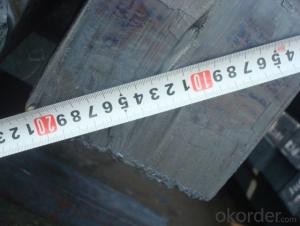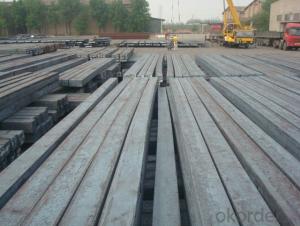Continue Casting Steel Billets/Blooms Manufactured By Blasting Furnace
- Loading Port:
- Qingdao
- Payment Terms:
- TT OR LC
- Min Order Qty:
- 1000 m.t.
- Supply Capability:
- 10000 m.t./month
OKorder Service Pledge
OKorder Financial Service
You Might Also Like
Continue Casting Steel Billets/Blooms Manufactured By Blasting Furnace
1.Structure of Casting Steel Billets/Blooms Manufactured By Blasting Furnace
Continue Casting Steel Billets/Blooms Manufactured By Blasting Furnace is the raw material of all kinds of steel mill. Billet section of square, round, flat, rectangular and abnormity, etc Several, mainly related to shape of rolled products. Simple rolled section steel, choose cross section of square billet or rectangular billet. rolling The sector products such as flat steel, Angle steel, select the rectangular billet or slab. Had better profiled billet when production beams, channels, and in rolling process Lines and improve the yield. The raw material of round billet is the production of seamless tube.
2.Main Features of Continue Casting Steel Billet Manufactured By Blasting Furnace.
Continue Casting Steel Billet Manufactured By Blasting Furnace section size should meet the requirements of rolling deformation and finished product quality, but also roll strength and biting condition of restrictions. General steel Billet section height H. And the roll diameter D The ratio of the ( namely H/D) Should be less than or equal to zero 0.5 . Length of steel billet by finishing temperature, Rolling time and the length of the product Or times ruler. When heated too long accident prone to bump the furnace wall of steel, too short, furnace bottom utilization rate is not high, influence the heating furnace production. For the production Choose a variety of steel and steel billet, should consider the affinities of billet, as far as possible in order to improve the productivity of the roughing mill, simplify the stock management of workshop.
3. Continue Casting Steel Billets/Blooms Manufactured By Blasting Furnace Images
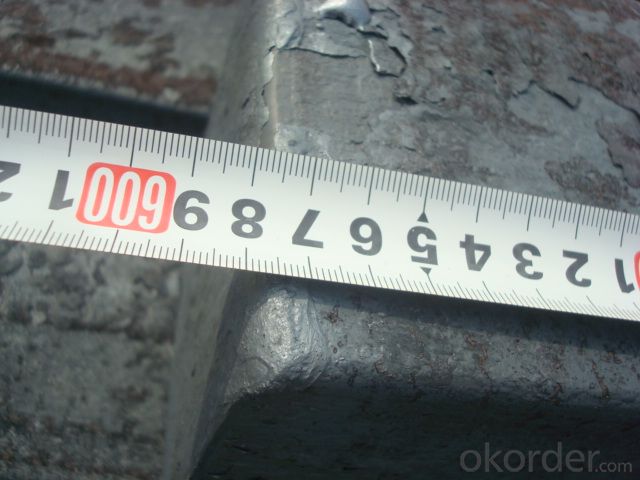
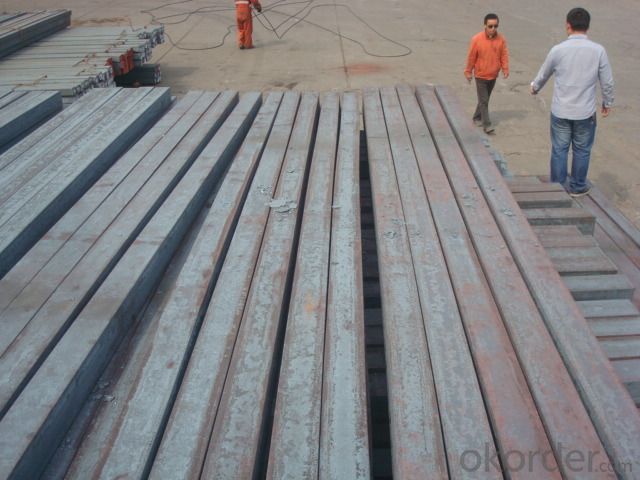
4. Continue Casting Steel Billets/Blooms Manufactured By Blasting Furnace Specification
Continue Casting Steel Billet Manufactured By Blasting Furnace rolled steel, after processing can be used for mechanical parts, forging parts, processing all kinds of steel, steel Q345B channel steel, wire rod is the role of the billet. Steel billet is used in the production of semi-finished products, generally cannot be used directly for the society. Steel billets and steel are strictly divided into standard, cannot decide to whether the business enterprise of the final product, and according to unified standards to perform the whole society. Typically, billet and the steel is relatively easy to distinguish, but for some steel billet, and have the same specification and same steel purposes (such as rolling tube billet), whether can be used for other industries, whether through steel processing process, whether through a finished product rolling mill processing to distinguish
There are three shapes of the steel billets: square billet, slab, rectangular billet The Chinese billet, rectangular billet is mainly suitable for rolling hot rolled strip, building reinforced bar, Ordinary wire, high speed wire rod and various small profile. Of the slab are mainly used for rolling plate and hot coil sheet.
The classification of the steel According to the quality classification (1)Ordinary steel (P 0.045% or less,S 0.050% or less)POn behalf ofphosphorus,s.On behalf ofsulfur Pands.Are all of the steelThe harmful elements, a leading toHot brittleness, a leading toCold brittle (2)High quality steel (P,s.both0.035% or less) (3)High quality steel (P 0.035% or less,S 0.030% or less)
Classified by chemical composition (1)Carbon steel: A.Low carbon steel (C 0.25% or less);Also known asMild steel ,The intensity ofLow,hardnessLow and soft, are often used in the manufacture of chainArticle, Rivet, Bolt, Shaft etc. .It includes most of theOrdinary carbon structural steelAnd part ofHigh quality carbonElement of structural steelMost,Without heat treatmentUsed in engineering structures, some classicscarburizingandOther heat treatmentUsed forrequirementsThe wear resistance of machine parts. B.Medium carbon steel (0.25 C or less 0.60% or less);There areKilled steel,Half killed steel,Rimmed steelWait for a variety of products.Hot working and good cutting performance,Poor welding performance.Plasticity and toughness lower than that of low carbon steel.Can beWithout heatTo deal with, the direct use ofHot rolled material,Cold drawn material, but alsoAfter heat treatmentAfter use.quenching,temperingIn the afterCarbon steel withGood comprehensive mechanical properties.To be able to achieveThe highest hardness is aboutHRC55 (HB538),sigmabfor600~1100 mpa.So in theModerate intensity levelA variety of purposes,Medium carbon steel is the most widelyApplied, in addition to asBuilding materialsOutside, still a lot for makingTo build all kinds of mechanical parts. C.High carbon steel (C 0.60% or higher).Often saidTool steel , you canhardenedandtempering .hammer,crowbarSuch as byCarbon content0.75%The steel manufacturing; Cutting tools such as drill bit,tap,reamerSuch as byCarbon content0.90%to1.00%Made of steel. (2)Alloy steel: A.Low alloy steel (alloy elements in total5% or less) B.Total content in alloy steel (alloy elements> 5 ~ 10%) C.High alloy steel (alloy elements in total> 10%).
5.FAQ of Continue Casting Steel Billets/Blooms Manufactured By Blasting Furnace
We have organized several common questions for our clients,may help you sincerely:
①How about your company?
A world class manufacturer & supplier of castings forging in carbon steel and alloy steel,is one of the large-scale professional investment casting production bases in China,consisting of both casting foundry forging and machining factory. Annually more than 8000 tons Precision casting and forging parts are exported to markets in Europe,America and Japan. OEM casting and forging service available according to customer’s requirements.
②How to guarantee the quality of the products?
We have established the international advanced quality management system,every link from raw material to final product we have strict quality test;We resolutely put an end to unqualified products flowing into the market. At the same time, we will provide necessary follow-up service assurance.
③How is the packaging and delivery?
Loose by Vessel and the delivery term is based on the the quantity and our factory’s schedule then.
- Q: How are steel billets used in the manufacturing of industrial machinery?
- Steel billets are used in the manufacturing of industrial machinery as raw materials that are shaped and processed into various components, such as gears, shafts, and frames. These billets are heated, forged, and machined to create the desired shapes and sizes, providing the necessary strength and durability for the machinery to function effectively in various applications.
- Q: How do steel billets contribute to the manufacturing of machinery and equipment?
- Steel billets play a crucial role in the manufacturing of machinery and equipment. These billets, which are essentially semi-finished steel products, are used as raw materials in various manufacturing processes. One of the primary ways steel billets contribute to the manufacturing of machinery and equipment is through the production of steel bars and rods. Steel billets are heated and then rolled or forged into these shapes, which are essential components in the construction of machinery and equipment. Steel bars and rods provide strength, durability, and stability to the structures of machines. Furthermore, steel billets are also used in the production of other steel components like gears, crankshafts, and axles. These components are vital for the proper functioning of machinery and equipment and require the high strength and toughness provided by steel billets. By using steel billets, manufacturers can ensure that their machinery and equipment can withstand heavy loads, vibrations, and other demanding conditions. In addition, steel billets are often used to produce steel pipes and tubes, which are widely used in various industries. These pipes and tubes are essential for the transportation of fluids, gases, and other materials within machinery and equipment. By using steel billets, manufacturers can produce pipes and tubes that are not only strong and durable but also resistant to corrosion and wear. Moreover, steel billets contribute to the manufacturing of machinery and equipment by enabling the production of precision-engineered components. These billets can be machined, drilled, and shaped to meet the specific requirements of different machinery and equipment. This flexibility allows manufacturers to create intricate and complex components that are essential for the efficient operation of machines. Overall, steel billets are an integral part of the manufacturing process for machinery and equipment. They provide the necessary strength, durability, and versatility required to produce components that can withstand the demanding conditions of industrial applications. Without steel billets, the manufacturing industry would struggle to produce machinery and equipment that are reliable, efficient, and long-lasting.
- Q: What is the role of steel billets in the manufacturing of construction cranes?
- Steel billets play a crucial role in the manufacturing of construction cranes as they serve as the raw material for creating the structural components of the crane. These billets are heated and then shaped into various sections such as beams and columns, which provide the strength and stability required for the crane to lift heavy loads. The use of steel billets ensures the durability and reliability of construction cranes, enabling them to withstand the demanding conditions of construction sites and safely perform their lifting tasks.
- Q: What are the potential applications of steel billets in the packaging industry?
- Steel billets have a wide range of potential applications within the packaging industry. One of the primary uses of steel billets is in the production of steel drums and barrels, which are widely used for packaging and transporting various materials such as chemicals, oils, and liquids. Steel billets can also be utilized in the manufacturing of steel cans, which are commonly used for packaging food and beverages. Steel cans offer excellent durability and strength, ensuring that the contents are well protected during transportation and storage. Additionally, steel cans provide an airtight seal, helping to preserve the freshness and quality of the packaged products. Furthermore, steel billets can be utilized in the production of steel strapping and bands, which are used for securing and bundling packaged goods. Steel strapping offers superior strength and resistance against breakage, making it an ideal choice for heavy-duty packaging requirements. Another potential application of steel billets in the packaging industry is in the production of wire mesh containers and pallets. These containers and pallets are commonly used for storing and transporting goods in warehouses and distribution centers. Steel billets provide the necessary strength and durability to withstand the weight and handling of various packaged materials. Moreover, steel billets can also be used in the production of steel tubes and pipes, which are utilized in the manufacturing of packaging machinery and equipment. These tubes and pipes serve as structural components in packaging machines, providing stability and strength to ensure proper functioning and longevity. Overall, the potential applications of steel billets in the packaging industry are vast and varied. From steel drums and cans to strapping and containers, steel billets offer the necessary strength, durability, and reliability required for packaging and transporting various products effectively.
- Q: How are steel billets cut into desired lengths?
- Various cutting techniques are commonly used to cut steel billets into desired lengths. One of the most frequently employed methods is saw cutting, where a high-speed circular saw with a carbide or diamond-tipped blade is utilized. By securing the billet in place, the saw blade is brought down to create the required length. Another method is torch cutting, which involves the use of an oxy-fuel torch. This torch produces a high-temperature flame directed onto the billet, causing it to melt and be cut through. Torch cutting is preferred for larger and thicker steel billets, as it allows for greater flexibility in cutting irregular shapes or angles. Moreover, plasma cutting is another technique utilized for cutting steel billets. It employs a plasma torch that generates an electrically conductive plasma arc. This arc melts the steel and blows away the molten metal, resulting in a precise and clean cut. Plasma cutting is particularly beneficial for thicker steel billets or intricate shapes and designs. In summary, the choice of cutting technique for steel billets depends on factors such as size, thickness, precision, accuracy, and specific requirements of the end product.
- Q: How are steel billets used in the production of seamless tubes?
- Steel billets are an important raw material used in the production of seamless tubes. They are primarily used in the initial stage of the manufacturing process, which involves the formation of seamless tubes through the hot rolling or extrusion method. To begin with, steel billets are heated to a high temperature to make them malleable. This process is known as hot rolling, and it allows the billets to be easily shaped and manipulated. The heated billets are then passed through a series of rollers or extrusion dies to form a cylindrical shape, which is the basic structure of a seamless tube. During the rolling or extrusion process, the steel billets undergo substantial deformation. The pressure applied by the rollers or dies forces the metal to flow and fill the cavities, resulting in the formation of a seamless tube. The size and shape of the billets determine the dimensions and specifications of the final seamless tube. Moreover, steel billets also contribute to the mechanical properties of the seamless tubes. The quality and composition of the billets play a crucial role in determining the strength, durability, and corrosion resistance of the tubes. Proper selection and quality control of the billets are essential to ensure the production of high-quality seamless tubes that meet industry standards and customer requirements. In conclusion, steel billets are indispensable in the production of seamless tubes. They are heated, formed, and shaped through the hot rolling or extrusion process, resulting in the creation of seamless tubes with specific dimensions and mechanical properties. The use of steel billets ensures the production of high-quality seamless tubes that are widely used in various industries, including oil and gas, automotive, construction, and manufacturing.
- Q: What is the average lifespan of a steel billet in a structural application?
- The average lifespan of a steel billet in a structural application can vary depending on various factors such as the quality of the steel, environmental conditions, maintenance practices, and the specific structural application. However, with proper care and maintenance, steel billets can generally have a lifespan of several decades or even longer in structural applications.
- Q: What are the different machining processes for steel billets?
- There are several machining processes that can be used for steel billets, depending on the desired outcome. Some common machining processes for steel billets include turning, milling, drilling, and grinding. Turning involves rotating the billet against a cutting tool to remove material and create a desired shape. Milling involves using a rotating cutter to remove material from the billet, typically in a perpendicular or angled direction. Drilling involves creating holes in the billet using a drill bit. Grinding involves using an abrasive wheel to remove material and create a smooth surface finish on the billet. These machining processes can be combined or used individually to achieve the desired shape, dimensions, and surface finish for the steel billet.
- Q: Can steel billets be used for making decorative items?
- Yes, steel billets can certainly be used for making decorative items. Steel is a versatile and strong material that can be shaped and molded into various forms. Depending on the design and skill of the craftsmen, steel billets can be transformed into beautiful decorative items such as sculptures, furniture, wall art, and other ornamental pieces. The durability and longevity of steel also make it an ideal choice for decorative items that need to withstand the test of time. Additionally, steel can be finished in different ways, such as polishing, painting, or adding other decorative elements, further enhancing its aesthetic appeal. Therefore, steel billets offer a great potential for creating unique and visually appealing decorative items.
- Q: Can steel billets be used in the production of industrial equipment?
- Industrial equipment can indeed utilize steel billets. These semi-finished metal products can undergo further processing to produce a wide range of industrial equipment, including machinery, tools, automotive parts, construction materials, and more. Steel's exceptional strength, durability, and adaptability make it the perfect material for manufacturing industrial equipment. By shaping, machining, and welding steel billets, intricate structures and components can be created, ensuring the necessary strength and stability for industrial applications. Furthermore, heat treatment can be applied to steel billets to enhance their mechanical properties, making them even more suitable for heavy-duty industrial equipment.
Send your message to us
Continue Casting Steel Billets/Blooms Manufactured By Blasting Furnace
- Loading Port:
- Qingdao
- Payment Terms:
- TT OR LC
- Min Order Qty:
- 1000 m.t.
- Supply Capability:
- 10000 m.t./month
OKorder Service Pledge
OKorder Financial Service
Similar products
Hot products
Hot Searches
Related keywords
